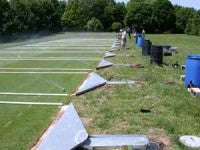Pesticide runoff trials USGA
Pesticide runoff trials USGA
Best Management Practices to Reduce Runoff of Pesticides Applied to Turfgrass
BY Bruce Branham,
University of Illinois
Department of Natural Resources and Environmental Sciences
Objectives:
1. Identify post-application irrigation schedules that minimise pesticide runoff potential.
2. Quantify the relationship between the time interval from pesticide application until a runoff event and the amount
of pesticide in that runoff.
3. Determine the impact of clipping removal following pesticide application on the quantity of pesticides in runoff.
Start Date: 2001
Project Duration: 2 years
Total Funding: $59,633
Pesticide use on golf courses has received a disproportionate amount of scrutiny from regulators and others because of the visibility of the turfgrass industry. Recently, it has become evident that runoff from turfgrasses can carry significant quantities of pesticides from treated surfaces. The purpose of this project was to examine practical means by which runoff from turfgrasses could be reduced. The construction of these runoff plots was described in previous reports. Briefly, the experimental area has a 5% downward slope and individual runoff plots were 10 by 30'(3.05 x 9.15 m). A total of ten runoff plots were used in each experiment.

We chose pesticides of high, medium, and low water solubility to use in each experiment. In the first experiment we used mefanoxam (Subdue Maxx®) (26000 mg/L water solubility), paclobutrazol (Trimmit®) (35 mg/L water solubility), and chlorothalonil (Daconil Ultrex®) (0.6 mg/L), which corresponded to high, medium, and low water solubilities, respectively.
The three pesticides were applied as a tank mix application and 0.25" of simulated irrigation was applied to individual plots at 0.25, 1, 4, 8, or 24 hours after pesticide application. Our hypothesis was that irrigation close to the time of pesticide application would wash the pesticide into the profile and reduce the amount of pesticide in runoff. Our data showed no clear trend and no significant reduction in runoff due to post-application irrigation.
Our second study examined the interval between pesticide application and the occurrence of a runoff event. A three-way tank mix of pesticides was applied to individual plots at 72, 48, 24, or 12 hours prior to the runoff event. As might be expected, we observed a reduction in pesticide concentrations in runoff water as the period between pesticide application and runoff event increased. However, the reduction in runoff water concentration was not significant for mefanoxam, the most water-soluble of the pesticides tested.
The most water-insoluble pesticide in the experiment, pendimethalin (Pendulum®, showed a significant reduction in concentration in runoff water when runoff occurred at 24, 48, or 72 hours after application (HAT) as compared to that occurred at 12 HAT. The pesticide of intermediate water solubility, the fungicide propiconazole (Banner®), showed a reduction in runoff concentration only at 72 HAT. Thus, the trend appears that the more water insoluble a pesticide is, the shorter the time on the leaf surface needed to significantly reduce the amount of pesticide that can be lost to runoff. Conversely, the more water-soluble a pesticide, the greater the risk of runoff, even several days after application.
The final experiment examined the effect of clipping removal versus clipping return on pesticide runoff. Clipping removal reduced pesticide concentrations in runoff water by 44, 21, and 53 % for mefanoxam, paclobutrazol, and chlorothalonil. While this would appear to be an effective practice to reduce potential runoff following pesticide applications, the removed clippings are a concentrated source of pesticide and must be disposed of properly before this could be considered a beneficial management practice.
Summary points:
- Light irrigation within 24 hours after pesticide application does not significantly reduce pesticide runoff.
- As the time between pesticide application and runoff event increases, the amount of pesticide in runoff decreases, but the more water soluble a pesticide, the slower the decrease with time.
- By removing clippings on the first mowing following a pesticide application, the potential for pesticide runoff can be dramatically reduced; however, the removed clippings contain a significant quantity of pesticide and must be handled properly to avoid creating a point-source pollution problem.
2003 USGA Turfgrass and Environmental Research summary.
Reproduced with kind permission of USGA Turfgrass and Environmental Research Program.
For further information you can visit www.usga.org
